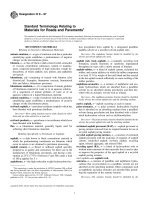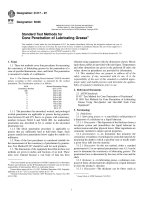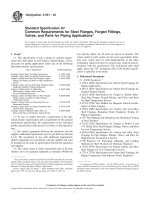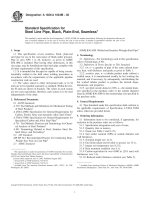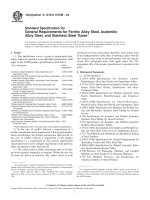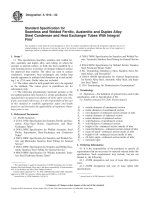Tiêu chuẩn ASTM a953 96 ;QTK1MY05NG
Bạn đang xem bản rút gọn của tài liệu. Xem và tải ngay bản đầy đủ của tài liệu tại đây (24.87 KB, 3 trang )
NOTICE:¬This¬standard¬has¬either¬been¬superseded¬and¬replaced¬by¬a¬new¬version¬or
discontinued.¬Contact¬ASTM¬International¬(www.astm.org)¬for¬the¬latest¬information.¬
Designation: A 953 – 96
An American National Standard
AMERICAN SOCIETY FOR TESTING AND MATERIALS
100 Barr Harbor Dr., West Conshohocken, PA 19428
Reprinted from the Annual Book of ASTM Standards. Copyright ASTM
Standard Specification for
Austenitic Chromium-Nickel-Silicon Alloy Steel Seamless
and Welded Tubing1
This standard is issued under the fixed designation A 953; the number immediately following the designation indicates the year of
original adoption or, in the case of revision, the year of last revision. A number in parentheses indicates the year of last reapproval. A
superscript epsilon (e) indicates an editorial change since the last revision or reapproval.
Stainless Steel Tubing (Small-Diameter) for General Service3
2.2 ANSI Standard:
B 31.3 Chemical Plant and Petroleum Refinery Piping4
2.3 ASME Pressure Vessel Code:
Section VIII Division 1, Pressure Vessels5
1. Scope
1.1 This specification covers grades of nominal-wallthickness, austenitic alloy steel tubing for general corrosionresisting and low- or high-temperature service, having a
specified minimum chromium content of less than 10.50 %.
1.2 The tubing sizes and thicknesses usually furnished to
this specification are 1⁄4 in. (6.4 mm) in inside diameter and
larger and 0.020 in. (0.51 mm) in nominal wall-thickness and
heavier.
1.3 Mechanical property requirements do not apply to
tubing smaller than 1⁄8 in. (3.2 mm) in inside diameter or 0.015
in. (0.38 mm) in thickness.
1.4 Some steels covered by this specification, especially the
high silicon containing steels, because of their particular alloy
content and specialized properties, may require special care in
their fabrication and welding. Specific procedures are of
fundamental importance, and it is presupposed that all parameters will be in accordance with approved methods capable of
producing the desired properties in the finished fabrication.
1.5 The values stated in either inch-pound units or SI units
are to be regarded separately as standard. The values stated in
each system are not exact equivalents; therefore, each system
must be used independently of the other. Combining values
from the two systems may result in nonconformance with the
specification. Unless the order specifies the applicable “M”
specification designation (SI units), the material shall be
furnished in inch-pound units.
3. Ordering Information
3.1 Orders for material under this specification should
include the following, as required, to describe the desired
material adequately:
3.1.1 Quantity (feet, metres, or number of lengths),
3.1.2 Name of material (seamless or welded tubes),
3.1.3 Grade (Table 1),
3.1.4 Size (outside diameter and nominal wall thickness),
3.1.5 Length (specific or random),
3.1.6 Test report required (see Section on Inspection of
Specification A 450/A 450M),
3.1.7 Specification designation, and
3.1.8 Special requirements.
4. General Requirements
4.1 Material furnished under this specification shall conform to the applicable requirements of the current edition of
Specification A 450/A 450M, unless otherwise provided
herein.
5. Manufacture
5.1 The tubes shall be made by the seamless or welded
process.
5.2 At the manufacturer’s option, tubing may be furnished
either hot finished or cold finished.
2. Referenced Documents
2.1 ASTM Standards:
A 370 Test Methods and Definitions for Mechanical Testing
of Steel Products2
A 450/A450M Specification for General Requirements for
Carbon, Ferritic Alloy, and Austenitic Alloy Steel Tubes3
A 480/A480M Specification for General Requirements for
Flat-Rolled Stainless and Heat-Resisting Steel Plate,
Sheet, and Strip2
A 632 Specification for Seamless and Welded Austenitic
6. Heat Treatment
6.1 All material shall be furnished in the heat-treated
condition. Except as provided in 6.2, the heat-treatment procedure shall, consist of heating the material to a minimum
temperature of 1900°F (1040°C) and quenching in water or
rapidly cooling by other means.
1
This specification is under the jurisdiction of ASTM Committee A-1 on Steel,
Stainless Steel, and Related Alloys and is the direct responsibility of Subcommittee
A01.10 on Steel Tubing.
Current edition approved March 10, 1996. Published May 1996.
2
Annual Book of ASTM Standards, Vol 01.03.
3
Annual Book of ASTM Standards, Vol 01.01.
4
Available from American National Standards Institute, W. 42nd St., 11th Floor,
New York, NY 10036.
5
Available from American Society for Mechanical Engineers, 345 E. 47th St.,
New York, NY 10017.
1
NOTICE:¬This¬standard¬has¬either¬been¬superseded¬and¬replaced¬by¬a¬new¬version¬or
discontinued.¬Contact¬ASTM¬International¬(www.astm.org)¬for¬the¬latest¬information.¬
A 953
TABLE 1 Chemical Requirements
TABLE 2 Number of Tubes in a Lot Heat Treated by the
Continuous Process
Grade
S70003
Size of Tube
UNS Designation
C max
Mn max
P max
S max
Si
Ni
Cr
Mo max
Fe
Size of Lot
2 in. and over in outside diameter and 0.200 in.
(5.08 mm) and over in wall thickness
Less than 2 in. but over 1 in. in outside diameter or
over 1 in. in outside diameter and under 0.200 in.
(5.06 mm) in wall thickness
1 in. or less in outside diameter
0.020
2.00
0.025
0.010
6.5–8.0
22.0–25.0
8.0–11.0
0.50
Balance
not more than 50 tubes
not more than 75 tubes
not more than 125 tubes
9.3 Hardness Test—Brinell or Rockwell hardness determination shall be made on specimens from two tubes from each
lot. The term lot applies to all tubes prior to cutting, of the same
nominal diameter and wall thickness that are produced from
the same heat of steel. When final heat treatment is in a
batch-type furnace, a lot shall include only those tubes of the
same size and the same heat which are heat treated in the same
furnace charge. When the final heat treatment is in a continuous
furnace, a lot shall include all tubes of the same size and heat,
heat treated in the same furnace at the same temperature, time
at heat, and furnace speed.
9.4 When more than one heat is involved, the flaring,
flanging, and hardness test requirements shall apply to each
heat.
9.5 Reverse Flattening Test—For welded tubes, one reverse
flattening test shall be made on a specimen from each 1500 ft
(460 m) of finished tubing. Coiled tubing greater than 1500 ft
(450 m) in length shall be sampled at both ends. A coil must be
continuous without any circumferential butt welds.
9.6 Hydrostatic or Nondestructive Electric Test—Each tube,
seamless or welded, shall be subjected to the Nondestructive
Electric Test or the Hydrostatic Test. Unless specified by the
purchaser, either test may be used at the option of the producer.
6.2 Controlled structural or special service characteristics
shall be specified as a guide for the most suitable heat
treatment. If the final heat treatment is at a temperature under
1900°F and is so specified on the order, each tube shall be
stenciled with the final heat treatment temperature in degrees
Fahrenheit after the suffix “HT.”
6.3 S70003 shall be heat treated in the range 1920°F
(1050°C) minimum to 2010°F (1100°C) maximum followed by
a water quench or rapid cooling by other means.
7. Chemical Composition
7.1 The steel shall conform to the requirements as to
chemical composition as prescribed in Table 1.
8. Product Analysis
8.1 An analysis of either one billet or one length of
flat-rolled stock or one tube shall be made from each heat. The
chemical composition thus determined shall conform to the
requirements specified.
8.2 A product analysis tolerance found in the Chemical
Requirements (Product Analysis Tolerances) table in Specification A 480/A 480M shall apply. The product analysis tolerance is not applicable to the carbon content for material with a
specified maximum carbon of 0.04 % or less.
8.3 If the original test for product analysis fails, retests of
two additional billets, lengths of flat-rolled stock, or tubes shall
be made. Both retests for the elements in question shall meet
the requirements of the specification; otherwise all remaining
material in the heat or lot shall be rejected or, at the option of
the producer, each billet, length of flat-rolled stock, or tube
may be individually tested for acceptance. Billets, lengths of
flat-rolled stock, or tubes which do not meet the requirements
of the specification shall be rejected.
10. Hardness Requirements
10.1 S70003 shall have a maximum hardness of 220 HV or
95 HRB in the annealed condition.
10.2 For tubing less than 0.065 in. (1.65 mm) in wall
thickness, it is permissible to use the Rockwell superficial
hardness test or the Vickers hardness test. The superficial
hardness number for S70003 shall not exceed 79 on the 30 T
scale or 91 on the 15 T scale.
10.3 No hardness test shall be required on tubes smaller
than 1⁄4 in. (6.4 mm) in inside diameter or tubes having a wall
thickness thinner than 0.020 in. (0.51 mm).
9. Mechanical Tests Required
9.1 Flaring Test (Seamless Tubes)—One test shall be made
on specimens from one end of one tube from each lot (Note 1)
of finished tubes.
11. Tensile Requirements
11.1 The tensile properties of the material shall conform to
the requirements of Table 3.
NOTE 1—The term lot applies to all tubes prior to cutting to length of
the same nominal size and wall thickness which are produced from the
same heat of steel. When final heat treatment is in a batch-type furnace, a
heat-treatment lot shall include only those tubes of the same size and from
the same heat that are heat treated in the same furnace charge. When the
final heat treatment is in a continuous furnace, the number of tubes of the
same size and from the same heat in a heat-treatment lot shall be
determined from the size of the tubes as prescribed in Table 2.
12. Permissible Variations in Dimensions
12.1 Variations in outside diameter, wall thickness, and
length, from those specified, shall not exceed the amounts
prescribed in Table 4.
12.2 The permissible variations in outside diameter given in
Table 4 are not sufficient to provide for ovality in thin-walled
tubes, as defined in the table. In such tubes, the maximum and
minimum diameters at any cross section shall deviate from the
nominal diameter by no more than twice the permissible
9.2 Flange Test (Welded Tubes)—One test shall be made on
specimens from one end of one tube from each lot (Note 1) of
finished tubes.
2
NOTICE:¬This¬standard¬has¬either¬been¬superseded¬and¬replaced¬by¬a¬new¬version¬or
discontinued.¬Contact¬ASTM¬International¬(www.astm.org)¬for¬the¬latest¬information.¬
A 953
TABLE 3 Tensile Requirements
Grade
UNS Designation
Tensile Strength,
min psi (MPa)
0.2 Y.S. min
psi (MPa)
Elongation 2 in.
or 50 mm or 4D
min, %
...
S70003
78 (540)
35 (240)
40
TABLE 4 Permissible Variations in Dimensions
Group
Size, Outside Diameter,
in.
Permissible Variations in
Outside Diameter,
in. (mm)
Permissible
Variations in
Wall
Thickness,A
%
Permissible Variations in
Cut Length, in. (mm)B
Over
Under
⁄ (3.2)
⁄ (3.2)
0
0
(4.8)
0
⁄ (4.8)
0
⁄
0
1
2
Up to 1⁄2
⁄ to 11⁄2, excl
60.005 (0.13)
60.005 (0.13)
615
610
18
12
3
1 1⁄2 to 3 1⁄2, excl
60.010 (0.25)
610
3 16
4
3 ⁄ to 5 ⁄ , excl
60.015 (0.38)
610
3 16
5
51⁄2 to 8, excl
60.030 (0.76)
610
3 16
12
12
18
⁄
(4.8)
Thin Walled TubesC
...
less than 0.065 in.
nominal
less than 0.095 in.
nominal
less than 0.150 in.
nominal
less than 0.150 in.
nominal
(1.65 mm)
(2.41 mm)
(3.81 mm)
(3.81 mm)
A
When tubes as ordered require wall thicknesses 3⁄4 in. (19.0 mm) or over, or an inside diameter 60 % or less of the outside diameter, a wider variation in wall thickness
is required. On such sizes a variation in wall thickness of 12.5 % over or under will be permitted.
For tubes less than 1⁄2in. (12.7 mm) in inside diameter which cannot be successfully drawn over a mandrel, the wall thickness may vary 615 % from that specified.
B
These tolerances apply to cut lengths up to and including 24 ft (7.3 m). For lengths over 24 ft an additional over tolerance of 1⁄8in. (3.2 mm) for each 10 ft (3.0 m) or
fraction thereof shall be permissible, up to a maximum tolerance of 1⁄2 in. (12.7 mm).
C
Ovality provisions of 12.2 apply.
variation in outside diameter given in Table 3; however, the
mean diameter at that cross section must still be within the
given permissible variation.
degrees Fahrenheit after the suffix “HT” if the final heat
treatment temperature is under 1900°F (1040°C).
14.2 When the Nondestructive Electric Test is performed,
each length of tubing shall be marked with the letters “NDE,”
and the certification, when required, shall also indicate this test.
13. Surface Condition
13.1 The tubes shall be pickled free of scale. When bright
annealing is used, pickling is not necessary.
15. Keywords
14. Product Marking
14.1 In addition to the marking prescribed in Specification
A 450/A 450M, the marking shall include whether the tubing is
seamless or welded and the final heat-treatment temperature in
15.1 steel; tube
The American Society for Testing and Materials takes no position respecting the validity of any patent rights asserted in connection
with any item mentioned in this standard. Users of this standard are expressly advised that determination of the validity of any such
patent rights, and the risk of infringement of such rights, are entirely their own responsibility.
This standard is subject to revision at any time by the responsible technical committee and must be reviewed every five years and
if not revised, either reapproved or withdrawn. Your comments are invited either for revision of this standard or for additional standards
and should be addressed to ASTM Headquarters. Your comments will receive careful consideration at a meeting of the responsible
technical committee, which you may attend. If you feel that your comments have not received a fair hearing you should make your
views known to the ASTM Committee on Standards, 100 Barr Harbor Drive, West Conshohocken, PA 19428.
3
